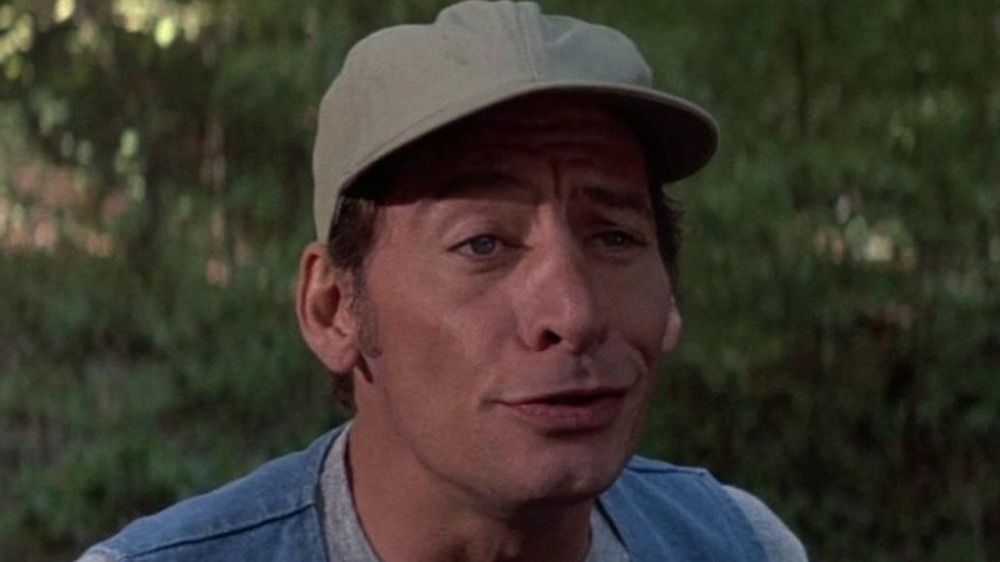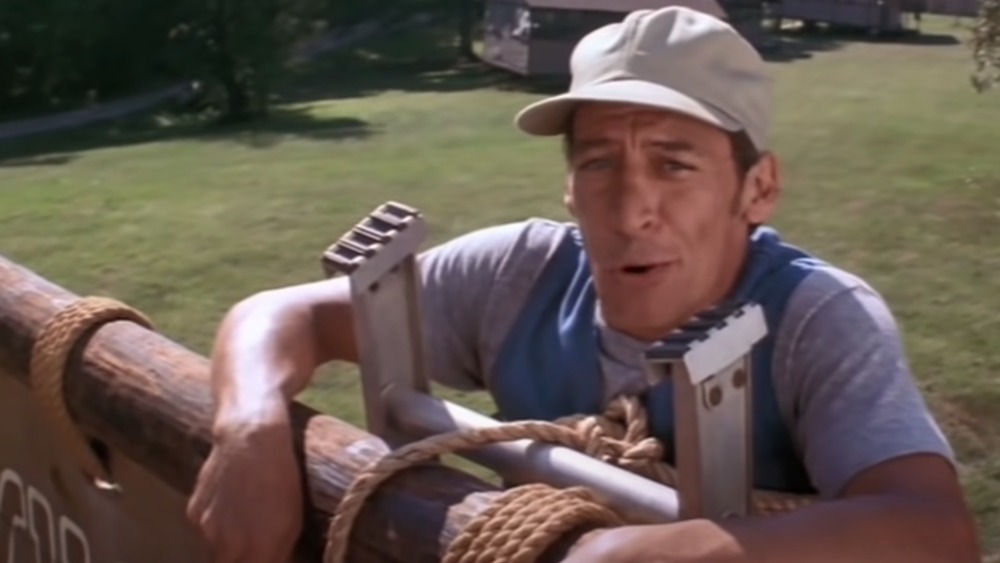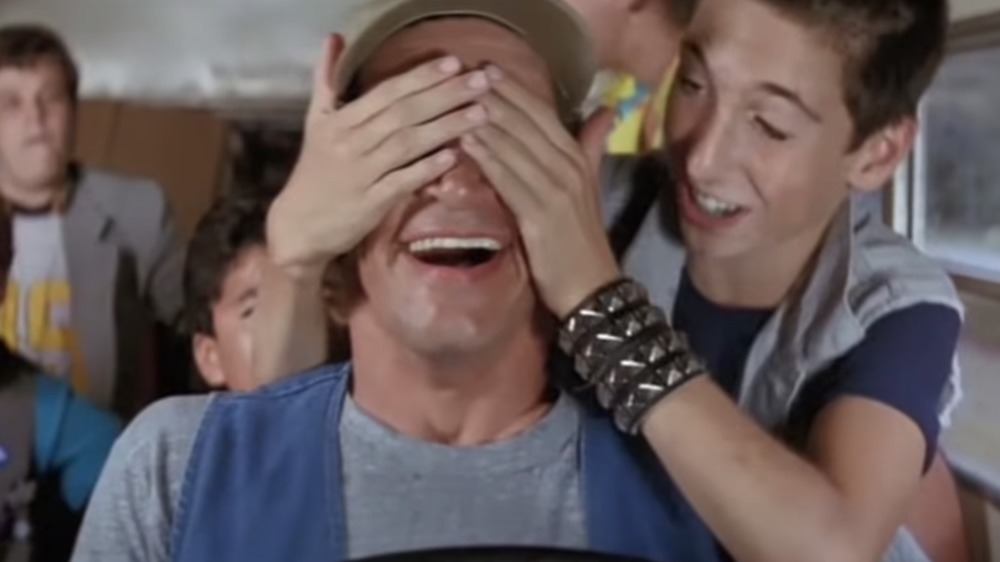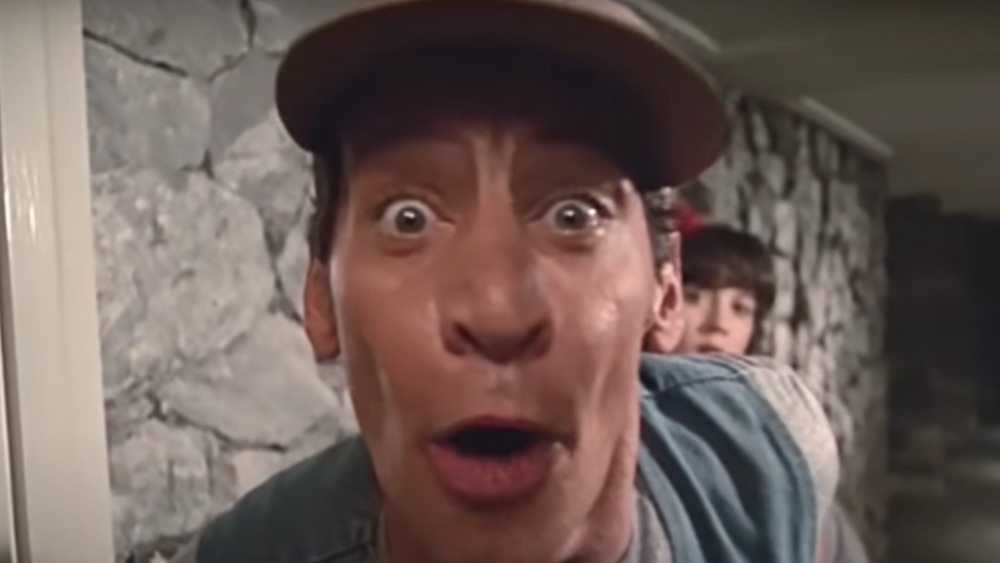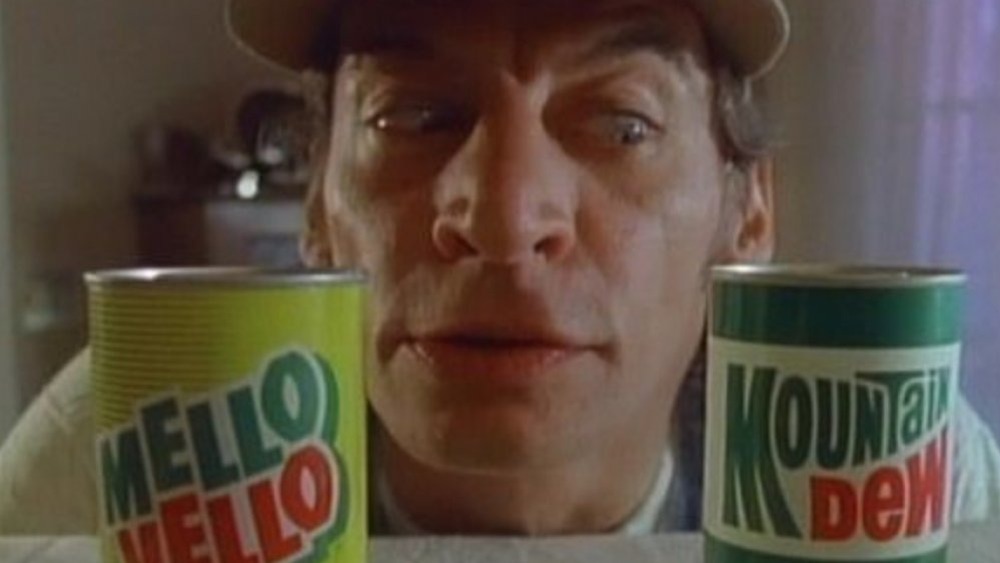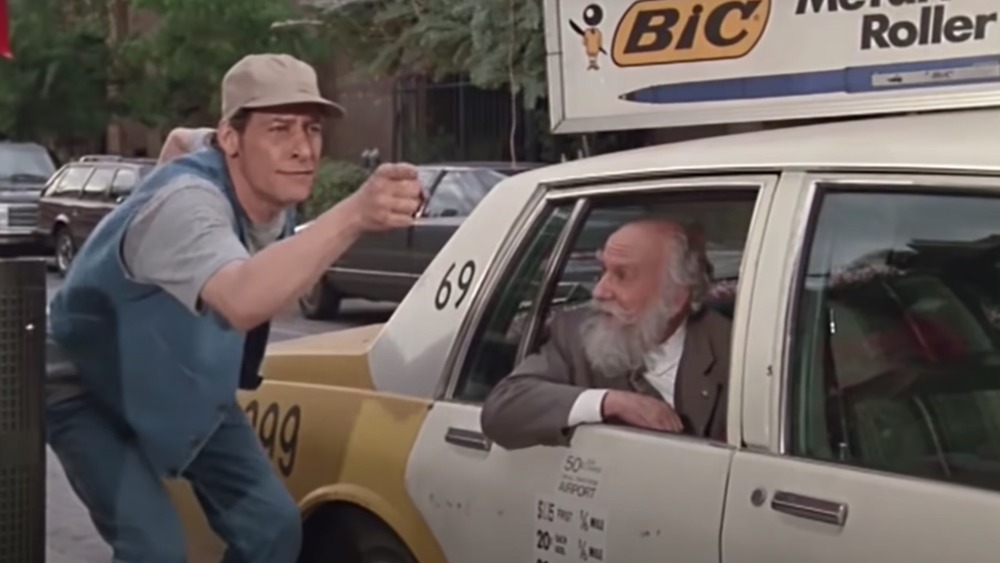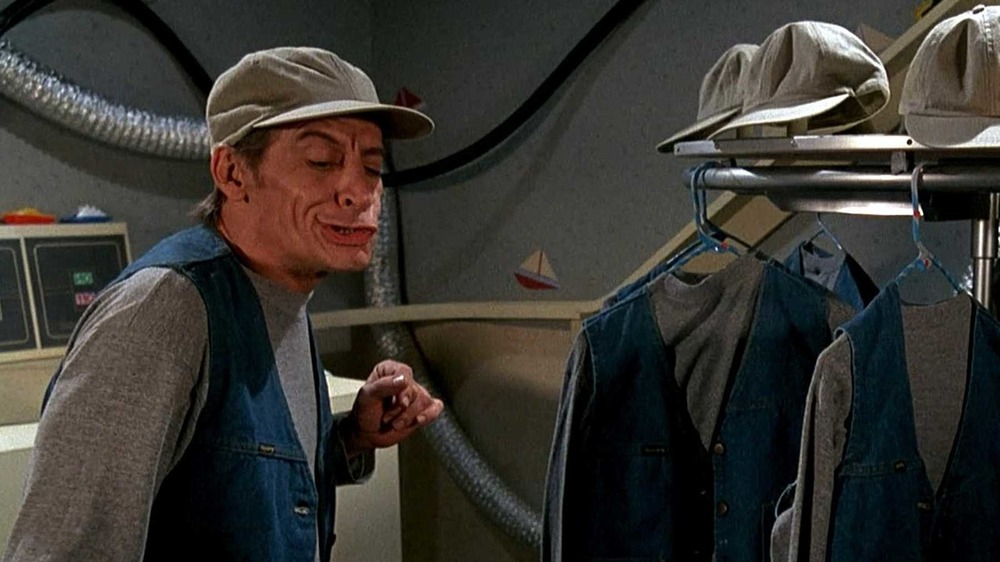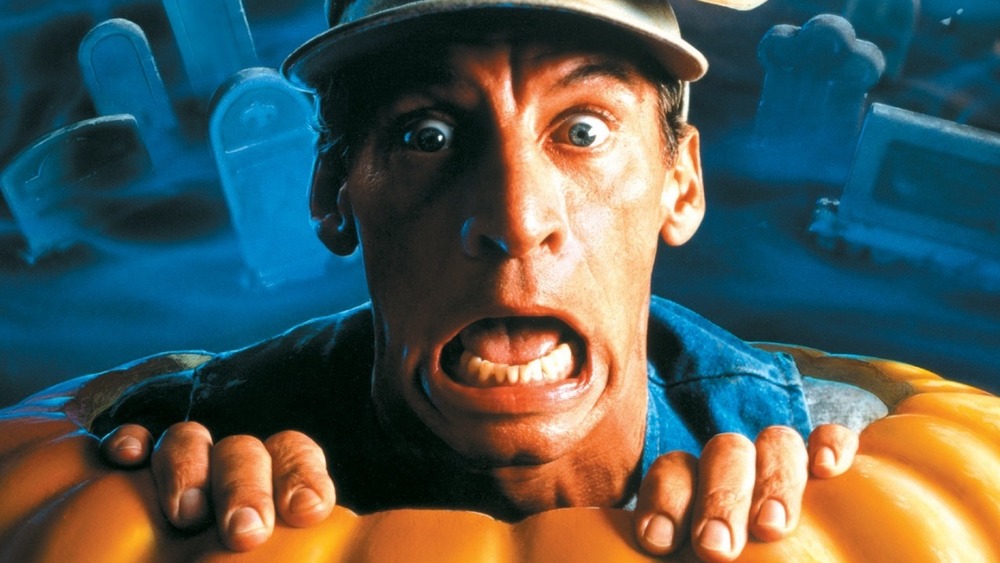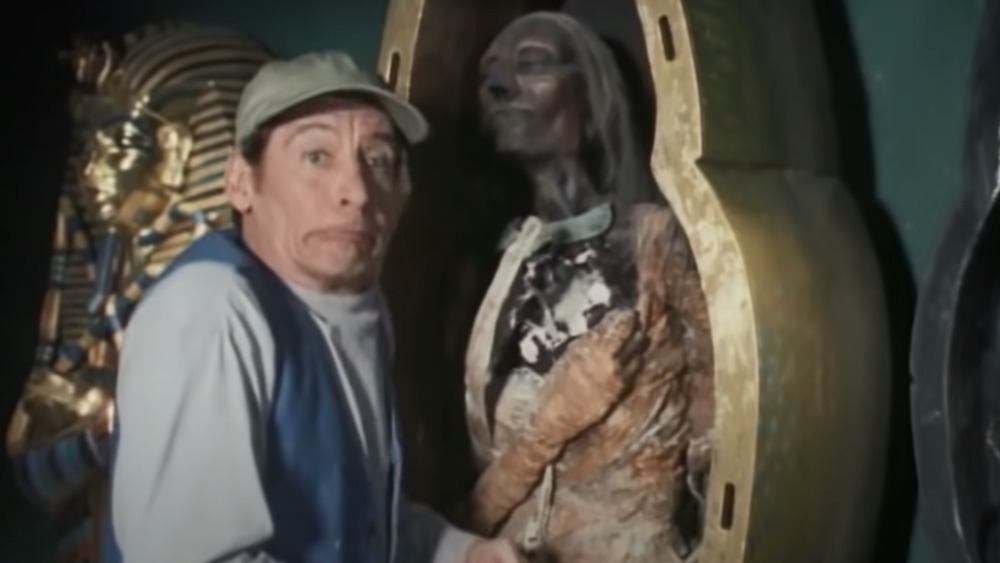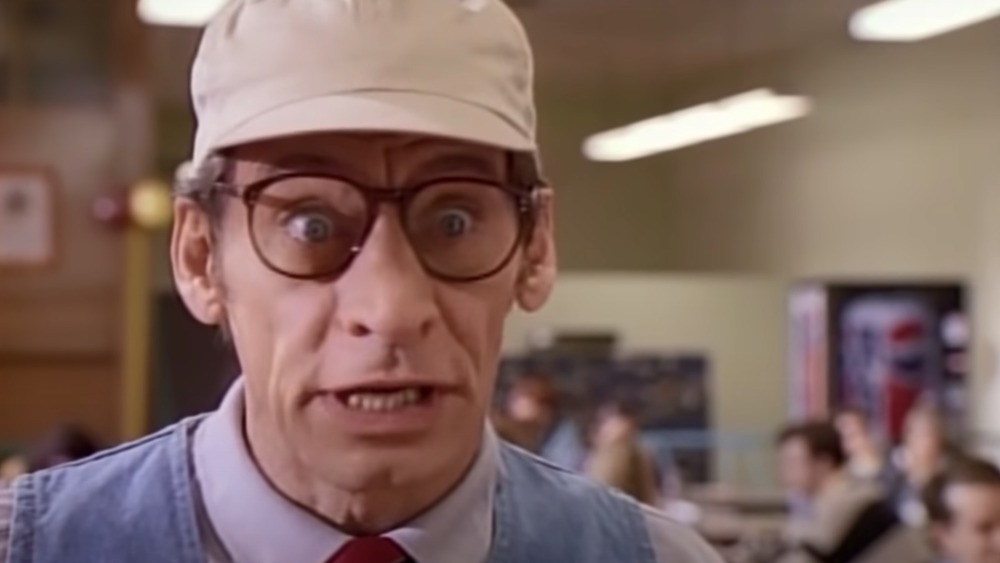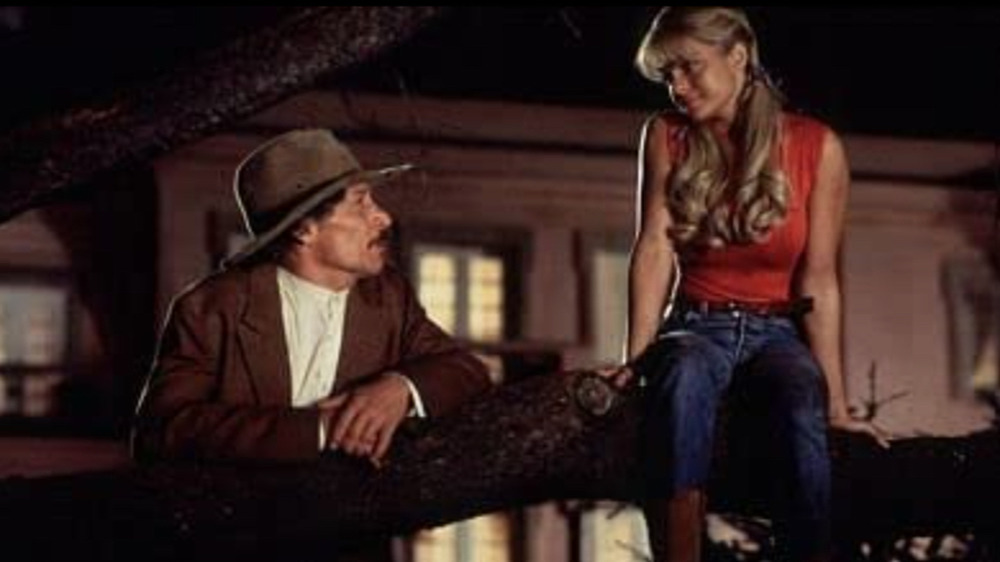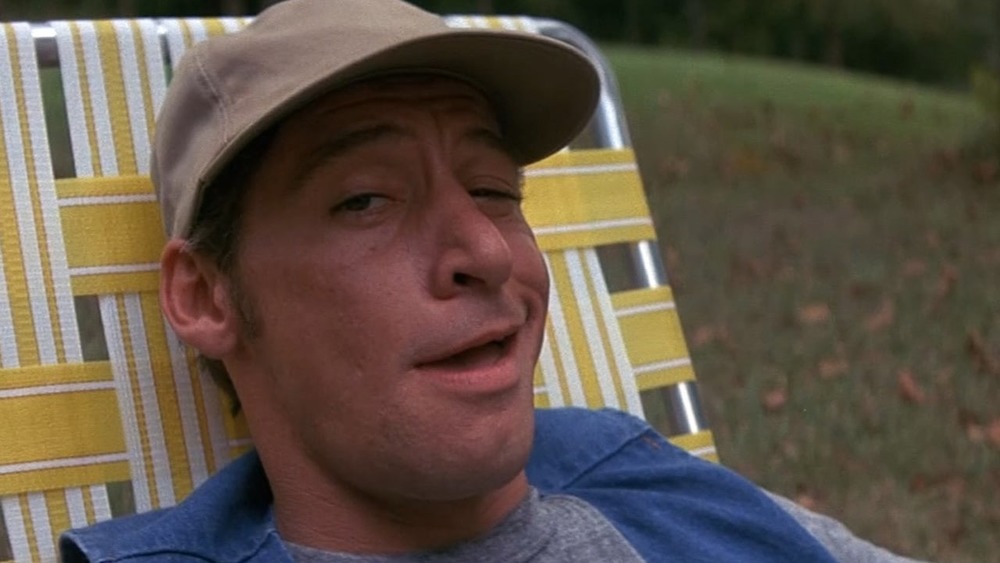The Untold Truth About Ernest P. Worrell
He defends truth and justice. He fights for the innocent, no matter the stakes. He dons the unblemished uniform of righteousness, which is recognized by his friends and foes alike the world over. His name is ... Ernest P. Worrell! Not the hero you were expecting? Well, Ernest has been bucking expectations ever since he first earned his spot in pop culture four decades ago.
How often does a character from a local advertising campaign turn into a national brand and cinematic icon of its own? When has a well-meaning simpleton been the most sought-after spokesperson for companies from multiple industries located coast to coast? What other advertising character has become the star of a string of hit films still beloved by fans years later? Not the Green Giant, Tony the Tiger, or the Geico Gecko. Only Ernest did all of that — and more!
Sure, most of Ernest's movies weren't, y'know, good, at least not in the traditional sense. But we'd gladly watch any Ernest movie before whatever this year's weepy Oscar bait movie is. Yet as much as we know about Ernest, there's so much more to the story. Behind the denim vest and tan hat was Jim Varney, one of the most underrated comic actors of his generation, who rubbed shoulders with Robin Williams, Tom Hanks, and Tim Allen before his untimely passing in 2000. You know the character — now discover the legend. Know what we mean? Here's the untold truth about Ernest P. Worrell!
The man behind Ernest P. Worrell could quote Shakespeare on a whim
According to Biography, James Varney Jr. was born in Lexington, Kentucky, on June 15, 1949, and he made his local theater debut at just 8 years old. While he enjoyed performing on stage, teachers got after him for his poor performance in school. Varney didn't listen, and he spent his teen years participating in acting competitions and performing at local coffee shops. In 1965, he got his first paycheck as an actor, playing Puck in a regional production of William Shakespeare's A Midsummer Night's Dream. In 1967, just two weeks shy of his high school graduation, Varney moved to New York City with just $65 in his pocket.
During his early years as a working actor, he performed in off-Broadway productions, dinner theater, and regional productions of classical theater, eventually bouncing back and forth between Kentucky and California, as well as driving a truck when times were tough. While his claim to fame was playing a moron, Jim Varney was anything but dim, as he could quote Shakespeare on a whim, and he was even said to boast a near genius-level IQ. Whether he really was that brainy may be a myth, but there's no denying that Varney was a highly intelligent actor who never lost his love of the Bard. In fact, after finding fame and fortune as Ernest years later, Varney played the tragic Prince of Denmark in a benefit production of Hamlet for Nashville's Shakespeare company. "To be, or not to be ... know what I mean?"
Before Ernest, Varney was a LA-based actor and standup comic
Jim Varney's pre-Ernest acting career was a mixed bag of big breaks and go-nowhere busts — not unlike a lot of actors hoping to make it big in the entertainment business. Still, he got some notable gigs along the way. In 1976, he was cast as a regular on Johnny Cash and Friends, and he would go on to appear in several short-lived TV shows, including Operation Petticoat, Fernwood 2 Night, and Pink Lady. He also found success as a touring stand-up comedian, doing sets for Johnny Carson and Merv Griffin, and he was gaining a small following on the Los Angeles comedy scene for his impressions and wacky characters. During his stand-up career, he also formed a close friendship with the late Robin Williams after working with him at Los Angeles' iconic Comedy Store in the mid-1970s.
After more than a decade in the entertainment business, Varney's stand-up and acting career was solid, if not spectacular. During an actor's strike in 1980, Varney decided to take a break from Hollywood and head back home to Kentucky. Trying to pick up local gigs as an actor, Varney got a part playing a military instructor named Sergeant Glory for a car dealership in Nashville, Tennessee. The spot was the brainchild of advertising executive John Cherry III, the man who would become the most important person in Varney's career.
Hey, Vern, Ernest is a hit!
John Cherry III had a problem. The executive vice president of the Cherry & Cherry advertising agency was representing an amusement park in Bowling Green, Kentucky, that was so run down and dilapidated the new owner didn't want to show it — but he still wanted to advertise it. How do you show off a product without, well, showing it? According to Entertainment Weekly, Cherry had to get creative, so he called in Jim Varney. Cherry came up with an obnoxious, over-the-top, loveable braggart who talked up the amusement park to his unseen buddy Vern, speaking directly to the camera, and thus the audience, too. It was a brilliantly simple setup ... and audiences hated it.
Cherry & Cherry later tried Ernest out for Nashville-based Purity Dairy, and according to Mental Floss, the spots made some parents angry, as Ernest's manic mug on a wide-angle lens freaked out kids. But Cherry stuck with Ernest, and eventually, his "hey, Vern!" catchphrase became a thing, with the denim-clad dummy hocking everything from milk and local news stations to ice cream and grocery stores in several states throughout the South, Midwest, and even up into the Mid-Atlantic and New England regions. In fact, the Virginia-based Tyson's Toyotoa saw a 50% increase in sales after running Ernest ads. By the time major brands like Sprite and Mello Yello came calling, the verdict was in — Ernest was a hit!
Ernest becomes an advertising icon
Ernest was a rare, unprecedented phenomenon in advertising — a spokesperson who wasn't associated with any one particular brand or company. Unlike the Brawny Man, Allstate's Mayhem, Ronald McDonald, or Snap, Crackle, and Pop, Ernest belonged exclusively to the Cherry & Cherry advertising agency, and thus, he was a freelance character-for-hire. And he stayed busy. Very busy. Thanks to the shoestring production budgets, the super easy, single-camera, one-take setups, and Jim Varney's rubber face and photographic memory, the company could easily film multiple Ernest commercials for a host of different clients in rapid-fire succession.
In fact, the agency once filmed a staggering 26 commercials in a single day. And Ernest's connection to the communities where his commercials ran was real. Even before Ernest went mainstream, people often thought he was just some local guy shooting a no-budget commercial. Which, in a way, he was. Cherry and Varney were hired by local and regional brands, which meant they got paid local and regional rates. "If they were national commercials, yeah — we'd own Ohio," Varney told the Los Angeles Times. While Cherry and Varney did eventually get major national brands, they had to turn down one of the biggest clients in the world, Chevrolet, due to obligations with local, competing car dealerships.
Disney sees dollar signs in Ernest P. Worrell
The "local guy" was becoming a national sensation. Beyond filming more than 3,000 local and regional commercials from coast to coast, from Oakhurst Dairy in Maine to Cerritos Auto Square in Southern California, Jim Varney was making sold-out appearances as Ernest across the country at malls and other events, including frequent Make-A-Wish visits. In 1986, Ernest made an appearance at the Indianapolis 500, also featuring one of the most popular characters ever, Mickey Mouse. But something unexpected happened. According to Hats Off Entertainment, Ernest got a better response from the live crowd than Mickey! Disney's then-CEO, Michael Eisner, was present at the Indy 500 that day and didn't get jealous. Instead, he pulled out his checkbook.
Disney partnered with Cherry to bring Ernest to the big screen under their Touchstone banner. The result? Ernest Goes to Camp, which made $23 million on a modest budget in 1987. Disney was in the Ernest business, and it would release the next four Ernest movies. Disney wanted to get the most out of the character and used him as a spokesperson, too. Ernest Goes to Splash Mountain aired on The Disney Channel on July 7, 1989, giving viewers an early look at up-and-coming attractions at Disneyland before the ride's official opening on July 17, 1989. Ernest's verdict? "Things like Splash Mountain keep you young. That and blood transfusions, organ transplants, cosmetic surgery ... I feel great!" We're sure he did. In less than ten years, Ernest went from local ad guy to part of Disney's media empire.
Ernest became Jim Varney's full-time job
Ernest's unexpected and unprecedented success had no prototype, except for maybe Superman's jump from comic books to cartoons, TV shows, and movies. However, there was one difference. With enough padding, anyone could play Superman — only Varney could play Ernest. And he was busy. Very busy. Ernest was Varney's full-time job. And he wasn't only swamped shooting the movie series for Disney. Varney and Cherry were still obligated to film commercials for an ever-expanding roster of brands that wanted to get in the Ernest business. According to Hats Off Entertainment, while Varney was thrilled to be making a living as an actor, he was concerned that he would be typecast as a bumbling doofus, which would interfere with his ambitions to be a supporting dramatic actor.
But an experienced performer like Varney knew you had to give the audience what they wanted, and they wanted Ernest. While Ernest was ubiquitous in the late 1980s, not everything was a hit. While Ernest was a human cartoon, his Pee-wee's Playhouse-esque 1988 CBS Saturday morning show, Hey Vern, It's Ernest!, was canceled after just one 13-episode season due to low ratings. It wasn't a total loss for Varney, who won a Daytime Emmy for Outstanding Performer in a Children's Series, one year after being nominated for a Razzie for Worst New Star in Ernest Goes to Camp.
Disney was scared stupid after the fourth Ernest film's failure
Disney made five Ernest films in total under their Touchstone banner, and they're probably what you think of when you think of Ernest movies. And thanks to their modest production budgets, most were profitable hits. After Ernest Goes to Camp surprised with $23 million in 1987, Ernest Saves Christmas earned $28 million in 1988, and Ernest Goes to Jail earned $25 million in 1990, with each film directed by the character's creator, former advertising executive John Cherry III.
While critic's scores were consistently poor (only Ernest Goes to Camp gets a "Fresh" rating), Cherry and company had plenty of ideas for future films, and Disney would've gladly made Ernest movies forever if they kept earning an average of $25 million. They didn't. Despite being one of the best in the series, Ernest Scared Stupid made only $14 million in 1991, as its "too scary for kids, too dumb for adults" mishmash didn't play well that October. Disney did what Disney does best — they read the pop cultural tea leaves and figured filmgoers were finished with the feckless, foolish buffoon. Despite more ideas in the till, Disney decided to part ways with Jim Varney. Ernest was only valuable to the Mouse House if he made green, know what we mean?
Ernest Rides Again was the last Ernest movie released to theaters
After Ernest Scared Stupid's financial failure in 1991, Disney was done with Ernest, but the character's creator John Cherry III and Jim Varney were not. Figuring Ernest was still a viable big-screen franchise, Cherry got independent financing for the next feature, Ernest Rides Again. Cherry's advertising agency, Cherry & Cherry, made a mint with their Ernest commercials by keeping the production budgets simple. They applied that same principle to all of the films, and they figured if Disney didn't need them, they didn't need Disney.
The team hoped Ernest Scared Stupid was a bump in the road, not an indication of fading audience interest. Alas, the movie gods spoke, and Ernest's big-screen prospects were sealed after Ernest Rides Again made a meager $1.4 million in 1993. That's not just a box office bomb — it's a flat-out catastrophe. Despite Ernest Rides Again concluding with a built-in commercial for the August 1994 theatrical release of his sixth adventure, Ernest Goes to School, Ernest would never be a theatrical property again, as his next four films would be released on home video.
There were many Ernest movies that were never made
Jim Varney played Ernest in more than 3,000 commercials from coast to coast, 13 episodes of Hey, Vern, It's Ernest! on CBS, and ten films, including a small part in 1986's Dr. Otto and the Riddle of the Gloom Beam. And that's not counting his numerous public appearances across the country. However, there were plans for even more Ernest films.
According to a 1990 Entertainment Weekly article, Ernest's would-be adventures included Ernest Spaced Out, Ernest and the Water Baby (described as Ernest meets E.T.), Ernest Scared Stupid (which was released in 1991, but instead of fighting trolls, Ernest was originally set to inherit his ancestor's haunted house), and Ernest and the Voodoo Curse. Frequent Varney collaborator Coke Sams noted (via Bloody Disgusting) Ernest and Voodoo Curse was set to be "the idiot version of Raiders of the Lost Ark," and would feature "lines of zombies, Voodoo potions, and Ernest pretending to be a zombie." As stoked as we would've been to see that, or any other piece of Ernest content, Jim Varney's tragic passing at age 50 due to lung cancer laid those plans to rest.
Jim Varney starred in other films besides Ernest
Jim Varney will always be associated with Ernest, though he played other parts, even after the denim-clad doofus became his claim to fame. While Varney's dream to be a serious character actor was never realized, he did get noteworthy dramatic roles on film and television. Varney's most famous on-screen, non-Ernest appearance came in 1993's The Beverly Hillbillies, playing the taciturn patriarch Jed Clampett in the remake of the 1960s TV show.
While Fox had some reservations about casting Varney in the role, he won them over, though Varney revealed in an interview with the Los Angeles Times that toning down his persona was tough at first. "For the first week, Penelope (Spheeris, the director) kept pulling back the reins. ... Just force of habit, I guess." Varney also revealed that during a screening, "I thought, 'Oh God, the first person that yells, 'Hey Vern,' I'm gonna just shrivel.' But they bought it. If they bought it, I buy it."
Showing there were no hard feelings after Ernest's deal died at Disney, Jim Varney played Slinky Dog in Toy Story and Toy Story 2. Varney also had two posthumous roles. There was writer-director-star Billy Bob Thorton's dramedy Daddy and Them, alongside an all-star cast that included Laura Dern, Ben Affleck, Kelly Preston, Jamie Lee Curtis, and Andy Griffith. And there was also Disney's Atlantis: The Lost Empire, which was dedicated to Varney's memory. Jim Varney died of lung cancer at age 50 on February 10, 2000.
Varney saw Ernest as a mixed blessing
Jim Varney saw Ernest as more of a blessing than a curse. Still, for a kind, intelligent man well-versed in William Shakespeare, working an exhausting schedule of playing a doofus for 20 years was a challenge. Varney went to great lengths to never appear ungrateful for his success as Ernest, though on occasion, he gave a peak behind the curtain. In an October 1991 interview with the Orlando Sentinel, Varney revealed Ernest was "a blessing and a curse because it's as hard to escape from as it is to get into it." Varney also noted that, "Whenever I do talk shows, I try to never appear as Ernest if I can help it," noting how Paul Reubens would always appear as Pee-wee Herman and that he thought "that hurt [Reubens] more than anything."
The fan group Varney never minded was kids. In a 1993 interview with the Los Angeles Times, Varney said, "The kids aren't bad. It's when you're on a dinner date with the tall blonde, and two guys in CAT hats come over and think you want to come see their power tools." Varney's nephew and biographer, Justin Lloyd, noted in his 2013 biography, The Importance of Being Ernest, "I don't know that Jim would have traded many of his years playing that character in exchange for any Academy or Tony Awards. ... I think he would be quite proud of the legacy of that character if he were still with us today."
